
Short video on blood typing for anatomy and physiology.
- Subject:
- Anatomy/Physiology
- Applied Science
- Health, Medicine and Nursing
- Life Science
- Material Type:
- Activity/Lab
- Author:
- Dr. Bruce Forciea
- Date Added:
- 04/02/2018

Short video on blood typing for anatomy and physiology.
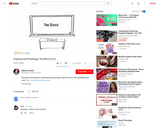
Short video on the blood for anatomy and physiology.
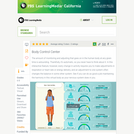
Throughout the day, your nervous system monitors and makes endless adjustments to your body's basic systems -- all to keep you alive. This interactive feature illustrates the complexity of such a task.

Short Description:
Body Physics sticks to the basic functioning of the human body, from motion to metabolism, as a common theme through which fundamental physics topics are introduced. Related practice, reinforcement and Lab activities are included. See the front matter for more details. Additional supplementary material, activities, and information can be found at: https://openoregon.pressbooks.pub/bpsupmat/. Order a print copy: http://www.lulu.com/content/paperback-book/body-physics-motion-to-metabolism/26081318
Long Description:
Body Physics sticks to the basic functioning of the human body, from motion to metabolism, as a common theme through which fundamental physics topics are introduced. Related practice, reinforcement and Lab activities are included. See the front matter for more details. Additional supplementary material, activities, and information can be found at: https://openoregon.pressbooks.pub/bpsupmat/. Specific topics covered in Body Physics are: scientific process, units, uncertainty, mass, density, weight, buoyant force, equilibrium, center of gravity, normal force, friction, torque, levers, mechanical advantage, tension, motion, impulse, momentum, the laws of motion, strength and elasticity of materials, work, kinetic and potential energy, power, thermal energy the first law of thermodynamics, efficiency, heat, entropy, and 2nd law of thermodynamics.
Word Count: 98402
(Note: This resource's metadata has been created automatically by reformatting and/or combining the information that the author initially provided as part of a bulk import process.)
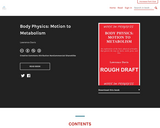
Short Description:
Body Physics sticks to the basic functioning of the human body, from motion to metabolism, as a common theme through which fundamental physics topics are introduced. Related practice, reinforcement and Lab activities are included. See the front matter for more details. Additional supplementary material, activities, and information can be found at: https://openoregon.pressbooks.pub/bpsupmat/. Order a print copy: http://www.lulu.com/content/paperback-book/body-physics-motion-to-metabolism/26081318
Long Description:
Body Physics sticks to the basic functioning of the human body, from motion to metabolism, as a common theme through which fundamental physics topics are introduced. Related practice, reinforcement and Lab activities are included. See the front matter for more details. Additional supplementary material, activities, and information can be found at: https://openoregon.pressbooks.pub/bpsupmat/. Specific topics covered in Body Physics are: scientific process, units, uncertainty, mass, density, weight, buoyant force, equilibrium, center of gravity, normal force, friction, torque, levers, mechanical advantage, tension, motion, impulse, momentum, the laws of motion, strength and elasticity of materials, work, kinetic and potential energy, power, thermal energy the first law of thermodynamics, efficiency, heat, entropy, and 2nd law of thermodynamics.
Order a print copy: http://www.lulu.com/content/paperback-book/body-physics-motion-to-metabolism/26081318
Word Count: 112607
ISBN: 978-1-63635-046-2
(Note: This resource's metadata has been created automatically by reformatting and/or combining the information that the author initially provided as part of a bulk import process.)
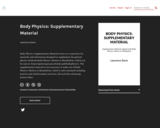
Short Description:
Body Physics: Supplementary Material serves as a repository for materials and information designed to supplement the general physics textbook Body Physics: Motion to Metabolism, which can be seen at: https://openoregon.pressbooks.pub/bodyphysics/. The supplementary material is not necessary to make use of Body Physics: Motion to Metabolism, which is self-contained including practice and reinforcement exercises, lab activities and group project ideas.
Long Description:
Body Physics: Supplementary Material serves as a repository for materials and information designed to supplement the general physics textbook Body Physics: Motion to Metabolism, which can be seen at: https://openoregon.pressbooks.pub/bodyphysics/. The supplementary material is not necessary to make use of Body Physics: Motion to Metabolism, which is self-contained including practice and reinforcement exercises, lab activities and group project ideas. Supplementary material includes: additional lab activities; content created by students through open pedagogy assignments; conference presentations about the design, development, and use of Body Physics; and research related to the use, assessment, and improvement of Body Physics (coming soon).
Word Count: 60301
(Note: This resource's metadata has been created automatically by reformatting and/or combining the information that the author initially provided as part of a bulk import process.)

Mechanical forces play a decisive role during development of tissues and organs, during remodeling following injury as well as in normal function. A stress field influences cell function primarily through deformation of the extracellular matrix to which cells are attached. Deformed cells express different biosynthetic activity relative to undeformed cells. The unit cell process paradigm combined with topics in connective tissue mechanics form the basis for discussions of several topics from cell biology, physiology, and medicine.
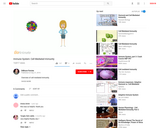
Short video on cell mediated immunity for anatomy and physiology.

Video tutorial for cellular respiration: overview, glycolysis, citric acid cycle and electron transport chain.
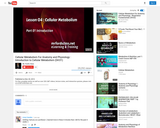
Anatomy and Physiology students must know the basics of cellular metabolism. This is an introduction to cellular metabolism.
Lesson 1 in our Cellular Metabolism For Anatomy and Physiology series. This is part of our Anatomy and Physiology lecture series.
If this video helps you please be sure to LST -like subscribe and tell your friends. Your support help us make more videos. For the complete series please visit http://mrfordsclass.net/
Videos in cell biology series:
- Introduction (04:01): http://youtu.be/efzWdP-i3Jo
- Respiration Fundamentals (04:02): http://youtu.be/5BIVqFptifc
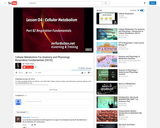
We introduce the general formula for cellular respiration as well as cover the difference between aerobic and anaerobic respiration.
Lesson 2 in our Cellular Metabolism For Anatomy and Physiology series. This is part of our Anatomy and Physiology lecture series.
If this video helps you please be sure to LST -like subscribe and tell your friends. Your support help us make more videos. For the complete series please visit http://mrfordsclass.net/
Videos in cell biology series:
- Introduction (04:01): http://youtu.be/efzWdP-i3Jo
- Respiration Fundamentals (04:02): http://youtu.be/5BIVqFptifc

This course includes:
Surveying the molecular and cellular mechanisms of neuronal communication.
Coversion channels in excitable membrane, synaptic transmission, and synaptic plasticity.
Correlation of the properties of ion channels and synaptic transmission with their physiological function such as learning and memory.
Discussion of the organizational principles for the formation of functional neural networks at synaptic and cellular levels.
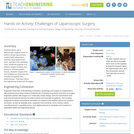
Students teams use a laparoscopic surgical trainer to perform simple laparoscopic surgery tasks (dissections, sutures) using laparoscopic tools. Just like in the operating room, where the purpose is to perform surgery carefully and quickly to minimize patient trauma, students' surgery time and mistakes are observed and recorded to quantify their performances. They learn about the engineering component of surgery.

Course materials including an instructor guide, course map, and weekly schedule for the third part of a three-part Anatomy and Physiology class. Includes learning objectives, assignments, formative feedback, learning activities, and readings from the OpenStax Anatomy and Physiology 2e open textbook.

Short video covering DNA replication for anatomy and physiology.
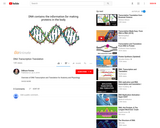
Short video covering DNA transcription/translation for Anatomy and Physiology.
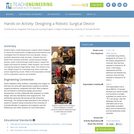
Student teams create laparoscopic surgical robots designed to reduce the invasiveness of diagnosing endometriosis and investigate how the disease forms and spreads. Using a synthetic abdominal cavity simulator, students test and iterate their remotely controlled, camera-toting prototype devices, which must fit through small incisions, inspect the organs and tissue for disease, obtain biopsies, and monitor via ongoing wireless image-taking. Note: This activity is the core design project for a semester-long, three-credit high school engineering course. Refer to the associated curricular unit for preparatory lessons and activities.

This resource is a video abstract of a research paper created by Research Square on behalf of its authors. It provides a synopsis that's easy to understand, and can be used to introduce the topics it covers to students, researchers, and the general public. The video's transcript is also provided in full, with a portion provided below for preview:
"The physiological effects of melatonin are far reaching, from acting as an neuroprotective agent to regulating circadian rhythms and sleep cycles. An imbalance of this hormone has even been linked to neurodegenerative diseases such as Parkinson’s, Alzheimer’s, and Huntington’s. The precise molecular mechanism by which melatonin exerts these effects, however, remains a mystery. To shed light on this process, a team of researchers has developed a melatonin-like compound that is unable to penetrate the cell membrane and binds only to cell-surface receptors. Melatonin’s physiological effects on the brain are controlled by the lock-and-key-like properties of this hormone and its receptors. When melatonin binds to its corresponding receptor, a biochemical signal is sent into the cell. But recent data suggests that this interaction may also occur inside the cell, itself. Specifically, on mitochondria within brain cells..."
The rest of the transcript, along with a link to the research itself, is available on the resource itself.

Following the steps of the iterative engineering design process, student teams use what they learned in the previous lessons and activity in this unit to research and choose materials for their model heart valves and test those materials to compare their properties to known properties of real heart valve tissues. Once testing is complete, they choose final materials and design and construct prototype valve models, then test them and evaluate their data. Based on their evaluations, students consider how they might redesign their models for improvement and then change some aspect of their models and retest aiming to design optimal heart valve models as solutions to the unit's overarching design challenge. They conclude by presenting for client review, in both verbal and written portfolio/report formats, summaries and descriptions of their final products with supporting data.

Short Description:
NewParaThis textbook is a project under development by our Biology faculty to ultimately provide students with all the factual information they need to succeed in the BIOL 1103 and BIOL 1109 courses at Douglas College in BC, Canada. If you have technical difficulty downloading this textbook, copy & paste the following direct link into your browser's address bar to allow you download the print .pdf version: https://pressbooks.bccampus.ca/dcbiol110311092nded/open/download?type=print-pdfNewParaNote: This open textbook has been imported into Pressbooks to make it easier for instructors to edit, build upon, and remix the content. There may be formatting errors in the book that need attention. We therefore recommend you review and edit this book before using it in your own classroom. For information about how to get your own copy of this book to work on, see the Clone a Book chapter in the Pressbooks Guide. You can access the original OpenStax version of this textbook on which this version is based here: Anatomy and Physiology
Long Description:
This textbook is a project under development by our Biology faculty to ultimately provide students with all the factual information they need to succeed in the BIOL 1103 and BIOL 1109 courses at Douglas College in BC, Canada. Readers should be aware that the information herein is subject to change at any time as corrections, additions, or other important modifications are made. Current students at Douglas College should be aware that only the most recent version of this textbook will be considered by their instructors to be complete and correct. The most recent version of this second edition will remain accessible online at https://pressbooks.bccampus.ca/dcbiol110311092nded/, and the most recent version of the second edition of the companion textbook (developed for Douglas College’s BIOL 1203 and BIOL 1209 courses) will also remain accessible online at https://pressbooks.bccampus.ca/dcbiol120312092nded/.
This textbook was developed initially as an adaptation of the OpenStax Anatomy & Physiology textbook, freely and perpetually available online at http://cnx.org/content/col11496/latest/. The original adaptations of that OpenStax textbook for Douglas College are accessible online at https://pressbooks.bccampus.ca/dcbiol11031109/ and https://pressbooks.bccampus.ca/dcbiol12031209/ In the first edition of the Douglas College adaptations the chapter and section numbers were left as they were in the version of the OpenStax A&P textbook, from which they were largely drawn. However, this second edition has been more extensively edited and rearranged to correspond with the curriculum used at Douglas College, so chapter and section numbers are no longer aligned specifically with the OpenStax A&P textbook.
Word Count: 114229
(Note: This resource's metadata has been created automatically by reformatting and/or combining the information that the author initially provided as part of a bulk import process.)